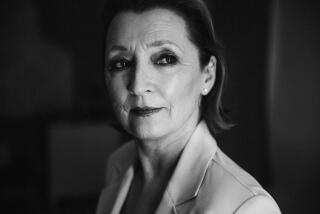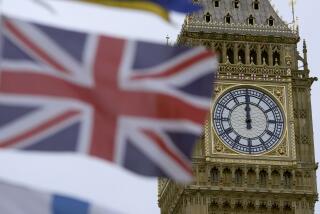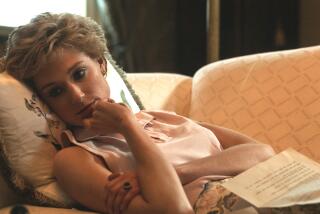Netflix’s ‘The Crown’ dives into the ups and downs of a power couple in Season 2
- Share via
In early May, the queen arrived at Hornsey Town Hall in London. The 1930s building, now an arts center, was standing in for a hospital on the final episode of the second season of “The Crown,” which premieres Dec. 8 on Netflix. The queen was actually actress Claire Foy, dressed in a perfectly crisp suit. A crowd gathered outside, watching Foy enter and exit a vintage car over the course of several takes, each time trying to get her motions exact. Later, inside the building, director Ben Caron debated with the crew over exactly how the hospital workers would greet their monarch.
These details are the essence of “The Crown,” created and written by Peter Morgan. Even areas of the Town Hall that wouldn’t appear in any shots were made up like the hallways of a 1960s hospital, a reminder that the show’s attention to the minutiae is one of the reasons it’s become such a success worldwide.
The 10 episodes of Season 2 were filmed on 398 sets with approximately 6,500 actors and extras over the course of nearly eight months. Morgan admits that it was a struggle to get Season 2 completed on time with his specifications, despite the reported production budget of $100 million. “It was only because they were so kind and agreed to shoot anything I wrote,” Morgan said. “They begged me to do fewer locations, but I don’t seem to be able to do that.” He added, “I just think the more specific you are, the better it is.”
Season 2 opens in 1956, detailing the response to the Suez Crisis, and runs through 1963, concluding with the retirement of former Prime Minister Harold Macmillan following the Profumo Affair. For Morgan, the challenge was to highlight iconic events of that time while also digging deeper to uncover events lost to the past. It took Morgan and his team of researchers a year to conceive and write the episodes.
“That process takes me ages,” Morgan said. “It’s what I spend the longest time doing — really mapping out the whole season. Part of the process is avoiding making this feel like one of those ridiculous history programs. You realize that history is so reductive and what has become the official narrative of the 1960s only tells part of the story. What you want to do is find some unexpected stories each time without making it obtuse and weird.”
One of these forgotten stories emerges midway through the season. In 1957, John Grigg, also known as Lord Altrincham, wrote an article speaking out against the queen. It marked the first time anyone had really criticized the royal family in a public manner and caused a serious outcry.
“It’s a real point of change for her and a real point of weakness in her character,” Foy explained of Elizabeth. “She becomes very affected by how the public perceives her. That’s not something she’s ever had to deal with — being criticized — really. Suddenly to be criticized and have her voice and what she looks like become something that everyone’s talking about, that’s when she’s really vulnerable.”
For Foy, a central theme of this season is how the queen reacts — or doesn’t react. We see the issues in her marriage to Prince Philip (Matt Smith) and her tenuous relationship to her sister Margaret (Vanessa Kirby), but in public, the queen historically has put on a careful, considered demeanor, sometimes even to her own detriment.
“I realized that, although she seemingly can handle everything in a calm, considered, unruffled way, I think in this [season] you see the wheels come off,” Foy noted. “You see how difficult she finds things and that actually her way of dealing with it is not healthy. She needs to lose her temper. She needs to let it out more. There is a point to where she could face up to the situation that she’s in and admit it to herself, but that would be too costly to do that and too painful.”
Elizabeth’s relationship to Philip takes center stage throughout much of the season, particularly as the couple faces raising several young children while running the country. For Smith, the tensions between the two are among the most interesting moments.
“He’s got a huge conflict in him between his duty to his wife and his duty to himself as a man,” Smith said. “All the conflicts in his marriage are always quite satisfying to play because it’s quite a rich tapestry emotionally.” He added, of the historical accuracy, “It’s Peter Morgan’s version of what happens. There wasn’t a camera in there recording these things. It’s impressionistic, but it’s based on as much fact as we can gather.”
Those intimate moments between the couple are one of the reasons viewers gravitate to “The Crown.” The Windsor family is unique in position and stature, but they’re like any other family in many ways.
“Ultimately it’s about the relationships between a mother and a daughter, a man and a wife, two sisters,” said Smith. “It’s about relationships in a work environment. It’s about things that are universal in nature and therefore I think it speaks to different cultures and people in different places around the world.”
“It’s a uniquely successful marriage, but that doesn’t mean it doesn’t have its ups and downs,” Morgan added of Elizabeth and Philip. “In those stresses and strains, that we all experience, we can identify.”
For Foy, the appeal of “The Crown” is in the idea that a TV series doesn’t need an extreme premise to gain an audience. Although Netflix doesn’t release viewership numbers, it’s clear that the show has fans from multiple generations who connect to these key moments in time and relate to the royal family, even from afar.
“Sometimes you can make something beautifully and with real heart and truth and just make it really, really, really well,” Foy said. “I think people see that on-screen. They see it’s not a manipulation of them as an audience or trying to appeal to them every five seconds or trying to subvert anything every five seconds. And the idea of seeing behind the veil and seeing this family when you never normally would and getting to know them as people is why they have taken it to their heart.”
“There are very few human beings that are alive who haven’t had [Elizabeth] as a central iconic character in their lives,” Morgan added. “She binds together people internationally. Everybody has been conscious of this woman and her life and her position. The image of her face has been everywhere.”
That face will change in Season 3, as new actors arrive to play the lead roles. So far only Olivia Colman has been cast to replace Foy for Seasons 3 and 4, after which another re-casting will take place for the planned final two seasons. Morgan’s intention was always to switch up the cast every two seasons, another instance of genuine detail. Colman was Morgan’s only choice to take over as Queen Elizabeth and according to him, she said yes immediately. She didn’t audition or read before being cast.
“It felt like a natural thing to do in the same way you see the queen’s portrait changing on the stamp,” Morgan noted. “It made sense to have somebody of the right age portraying her.”
Foy will miss the show, but has always been prepared for her inevitable exit. “We knew that from the very beginning,” the actress said. “These parts have already been reincarnated several times. I’m not the first person to play her. So that is in the nature of the story for them to carry on and change and evolve into someone else.”
The actress is aware of the power a show like “The Crown,” which reaches so many different people, can have. She doesn’t necessarily believe that we should look to the past for lessons, but Foy sees “The Crown” as a strong reminder that humanity does often reflect backward.
“It’s very important to look at what is happening now and think about how on earth it will be viewed in 60, 70, 80, 90 years and what future generations will think of the choices that we’re making now,” said Foy. “And what does it mean? What are the consequences of the decisions we’re making? Sometimes people could do with stepping back and going, ‘What is the message we’re trying to send out to our future generations about who we are now?’”
More to Read
The biggest entertainment stories
Get our big stories about Hollywood, film, television, music, arts, culture and more right in your inbox as soon as they publish.
You may occasionally receive promotional content from the Los Angeles Times.










